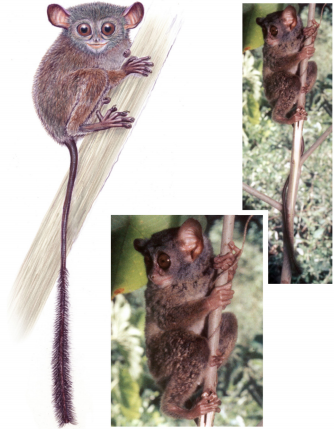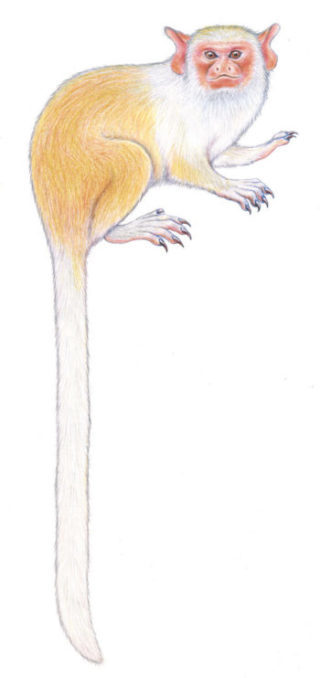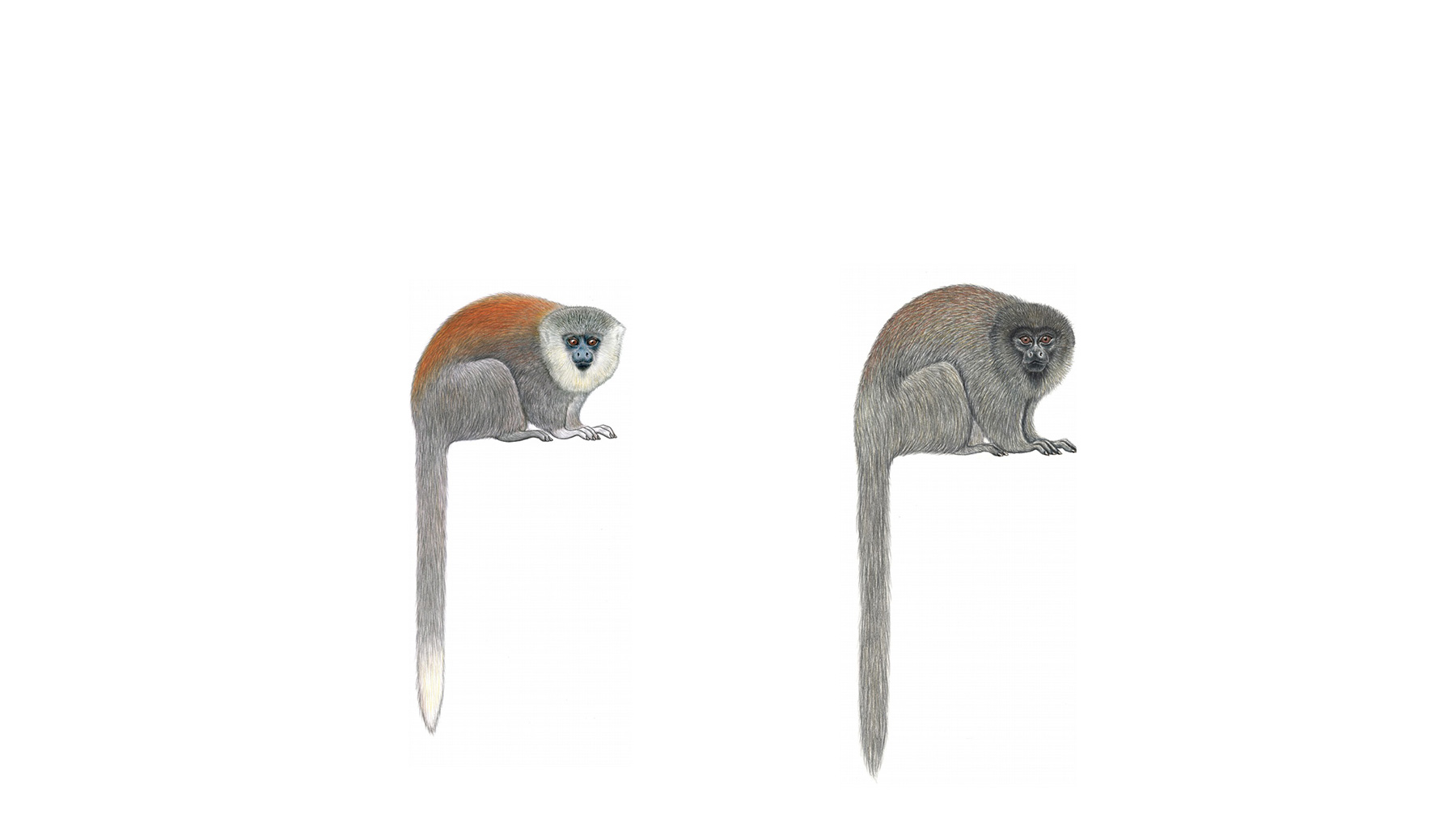- In 2019, Mongabay covered several announcements of new-to-science species.
- The “discovery” of a new-to-science species is always an awe-inspiring bit of news; the outcome of dogged perseverance, months or years of field surveys, and long periods of sifting through hundreds of museum records.
- In no particular order, we present our 15 top picks.
The discovery of a new-to-science species is always an awe-inspiring bit of news, filling us with hope. This year, researchers introduced us to several such species. Some were the result of a chance encounter; some were cases of researchers revisiting known plants and animals and giving them new identities. But most “discoveries” were the outcome of dogged perseverance, months or years of field surveys, and long periods of sifting through hundreds of museum records.
Mongabay covered many of these stories. Below, in no particular order, we present our 15 top picks.
1. Amazonian tree with human-sized leaves finally gets ID’d as new species

This is a story of incredible patience. Botanists first encountered individuals of this tree in 1982 while surveying the Madeira River Basin in the Brazilian Amazon. They knew it was a species of Coccoloba, a genus of flowering plants that grows in the tropical forests of the Americas, but they couldn’t pinpoint the species. The individual trees they came across weren’t bearing any flowers or fruits then, parts that are essential to describing a plant species, and the trees’ leaves were too large to dehydrate, press and carry back with them.
While the plant, and its massive leaves, became locally famous, it was only in 2005, that the researchers finally collected some seeds and dying flowers from a tree. These materials weren’t good enough to describe the plant species, but the researchers sowed the seeds at the campus of the National Institute of Amazonian Research (INPA), grew the seedlings, and waited. Thirteen years later, in 2018, one of the planted trees flourished and fruited, finally giving the researchers the botanical material they needed to describe the new species. The new species, named C. gigantifolia in reference to the plant’s giant leaves, grows to about 15 meters (49 feet) in height and has leaves that can reach 2.5 meters (8 feet) in length, likely the largest known leaf among dicotyledonous plants — a large group of flowering plants that include sunflowers, hibiscus, tomatoes and roses.
2. This grouper species collected from an Australian fish market almost became someone’s dinner

It’s not everyday that you find a previously undescribed species in a fish market, but that’s exactly what Jeff Johnson, an ichthyologist with Australia’s Queensland Museum, did. He had first heard of a mystery grouper 15 years back, and since then, received occasional photographs of the fish, which he thought was a potential new-to-science species. In 2017, when a fisherman sent Johnson a picture of the grouper yet again, Johnson tracked down the market where the fisherman had sold the fish, and bought all five individuals of the fish he found there. Then, together with his colleagues, Johnson analyzed the fish’s DNA, and compared it to those of related species in the museum. Finally, in a new paper published this year, the researchers confirmed that the grouper is indeed new to science, and they named it Epinephelus fuscomarginatus.
3. Meet Mini mum, Mini ature, Mini scule: Tiny new frogs from Madagascar

This year, herpetologists introduced us to three previously undescribed species of extremely small frogs from Madagascar, aptly named Mini mum, Mini ature, and Mini scule. All of them, just a few millimeters long, belong to Mini, a genus that is also entirely new to science. The new frog species are known from just a handful of locations, and may already be threatened with extinction. Researchers have recorded Mini mum only in Manombo Special Reserve in southeast Madagascar, for example, while Mini scule is known only from the fragmented forests of Sainte Luce Reserve. The areas in which the frogs occur are also likely small, threatened and declining.
4. Newly described Chinese giant salamander may be world’s largest amphibian

For a long time, the Chinese giant salamander, which reaches lengths of more than 5 feet (1.6 meters) and is the world’s largest known living species of amphibian, was considered to be a single species, Andrias davidianus. In the past, some researchers did suspect that the salamander was probably multiple species, but a new study published this year backed the suspicion with evidence. Researchers analyzed samples of the salamander from a series of historical museum specimens to see what local wild populations of the amphibian may have been like before humans started farming the animals and moving them around extensively, and found that the salamander is not just one, but three distinct species. These include A. davidianus, A. sligoi, and a third species that hadn’t been named at the time the study was published. Of the three recognized species, the South China giant salamander (A. sligoi) is most likely the largest, reaching 2 meters (6 feet) in length, the researchers say.
5. It took 25 years to describe Indonesia’s newest tarsier

Scientists Alexandra Nietsch and Carsten Niemitz first spotted this tarsier on the Togean Islands off Sulawesi, Indonesia, in 1993. Locals have known of the primate by the names bunsing, tangkasi and podi. But it took researchers more than 25 years of detailed study, including the tarsier’s vocalization and DNA, to finally describe the small primate as a species that’s new to science in a paper published in 2019. They named the species Niemitz’s tarsier (Tarsius niemitzi) in honor of the scientist who was one of the first to bring it to the attention of the scientific world. The description of Niemitz’s tarsier has increased the number of known tarsier species in Sulawesi and surrounding islands to 12, but the authors say the islands could be home to at least 16.
6. Some of these nine newly described Fijian bees are restricted to a single mountaintop

This year, researchers described nine new species of bees from the island country of Fiji in the southern Pacific Ocean. These colorful bees in shades of black, golden-green, and metallic, with hints of purple iridescence, are part of the genus Homalictus Cockerell, a group that’s not been taxonomically reviewed in Fiji for 40 years. Many of these bees either have very restricted distributions or are known only from single mountaintops, according to the researchers, and could soon become extinct due to changes in climate and other environmental risks. One new-to-science species, Homalictus terminalis, for example, has only been found on Mount Batilamu, where it seems to be restricted to the top 95 meters (312 feet) of the mountain peak. Another newly described species, H. ostridorsum, has only been recorded on Mount Tomanivi, while H. taveuni is named after the island of Taveuni, the only place it is known from.
7. Newly described marmoset species live in part of Amazon forest area that’s fast disappearing

When researchers surveying the stretch of Amazon forest lying between the Tapajós and Jamanxim rivers in the Brazilian state of Pará, chanced upon a group of three marmosets with white tails, they suspected that it was a potential new-to-science species. White tails are very rare among primates that live in South America; only one other primate species have it. The researchers were right. After studying the monkeys in both the forest and the laboratory, they confirmed that the marmoset, with its distinct white tail, white forearms with a beige-yellowish spot on the elbow, and white feet and hands, was a new species. The marmoset has been named Mico munduruku after the Munduruku, an indigenous group of people who live in the Tapajós–Jamanxim interfluve. It’s not all good news, though. The Amazon forest that’s home to M. munduruku is being rapidly cut for agricultural expansion, logging, hydroelectric power plants, and gold mining.
8. This new-to-science monkey lives in an ‘island’ amid deforestation in Brazil

This year, scientists announced a second, new-to-science species of monkey, also found in the Amazon rainforest. The grey monkeys, named Plecturocebus parecis after the Parecis plateau in Rondônia in Brazil where they are found, were first seen by scientists in 1914. Locally known as the “otôhô,” researchers subsequently saw the monkeys once again in 2011 and confirmed that it was sufficiently distinct from the closely related ashy black titi to be classified as a separate species. The titi monkey’s habitat lies within in the “Arc of Deforestation,” an area of high deforestation where vast swathes of forest have been cleared for cattle ranching and mechanized soy farms. But so far, the monkeys seem to have escaped some of the damage because the steep slopes of the plateau they occupy offer them protection by making the habitat hard to access and unappealing for large-scale deforestation.
9. New species of orange-red praying mantis mimics a wasp

Praying mantises tend to resemble leaves or tree trunks and come in shades of green and brown. But in 2013, researchers spotted a bright orange-red mantis with a black abdomen in a research station on the banks of the Amazon River in northern Peru. The praying mantis was not only mimicking a wasp’s bright colors, but also a wasp’s movements. Such conspicuous mimicry of wasps is rare among mantises, making this finding exciting, the researchers wrote in a paper published this year. The new-to-science species was named Vespamantoida wherleyi, the genus name Vespamantoida meaning wasp-mantis.
10. New species of giant flying squirrel brings hope to one of the world’s ‘most wanted.’

Giant flying squirrels belonging to the group Biswamoyopterus are incredibly rare. The first species described in the genus, the Namdapha flying squirrel (Biswamoyopterus biswasi) from India, has been seen by researchers only once in 1981. Its Laotian relative, the Laotian giant flying squirrel (Biswamoyopterus laoensis), was first spotted by researchers in bushmeat markets of Lao PDR (Laos) in 2012. Both species are known from a single specimen each. This year, scientists in China introduced us to a third species of the genus, Mount Gaoligong flying squirrel (B. gaoligongensis), which they first spotted in the collection of the Chinese Academy of Sciences. Thankfully, the team could subsequently observe the animals in the field as well and collect another specimen. Compared to the “lost” Namdapha and Laotian giant flying squirrels, researchers say that Mount Gaoligong flying squirrel’s conservation status looks “slightly optimistic.”
11. Newly described pocket shark likely glows in the dark

The new-to-science American pocket shark (Mollisquama mississippiensis) is the world’s second pocket shark species to be described. Researchers were surveying the eastern Gulf of Mexico to study what sperm whales eat when they collected a large sample of animals from the ocean’s depths. Among the collection was a small shark that the team hadn’t seen before. As it turned out, the animal was a previously undescribed species of pocket shark (the pocket shark gets its names not for its small size but because of small pocket-like openings or glands found behind each of its pectoral fins). This year, the researchers introduced the American pocket shark to us in a new paper, noting that the species has numerous light-producing organs or photophores covering much of the body, which possibly helps the shark glow in the dark depths of the deep sea.
12. Newly described tree species from custard apple family is likely endangered

This tree, which grows up to 20 meters (66 feet) in height and bears white flowers, is extremely rare. So far, the newly described species, belonging to the custard apple family of trees, or Annonaceae, is known only from the Usambara mountains of northeastern Tanzania — a few individuals have been observed in the Amani Nature Reserve in the Eastern Usambara Mountains and one in a private reserve in western Usambara. Both reserves are ‘islands’ within a deforested landscape with an extensive clearance of forest in neighboring areas, the researchers write in a paper published this year. Researchers have named it Mischogyne iddii, after Iddi Rajabu, a resident botanist at the Amani Nature Reserve, and they estimate that fewer than 50 individuals of the tree remain in the wild.
13. A new species of venomous pit viper was described from India

In May 2016, wildlife researcher Rohan Pandit and his teammate Wangchu Phiang, a member of the indigenous Bugun tribe living in the northeastern state of Arunachal Pradesh in India, were surveying Arunachal’s biodiversity when they stumbled upon a snake amid the leaf litter. Pandit knew it was a species of viper, a group of venomous snakes with folding fangs, but it was unlike anything he’d seen before. So he bagged the snake and examined it in detail later, collaborating with other herpetologists to analyze the snake’s morphology and DNA. The team confirmed that the viper was a new-to-science species, and they named it Trimeresurus arunachalensis, or Arunachal pit viper. The new species is closely related to the Tibetan pit viper (Trimeresurus tibetanus), a snake known only from Tibet, but physically and anatomically, the two species are quite distinct, the researchers say.
14. New species of leaf-mimicking lizard could already be victim of pet trade

The leaf-tailed gecko is a master of camouflage. These lizards, belonging to the genus Uroplatus, are found only in the forests of Madagascar and have body shapes and colors that allow them to merge with dried leaves seamlessly. Researchers described a new-to-science species of a leaf-tailed gecko from Marojejy National Park in northeastern Madagascar this year, and it may already be threatened with extinction because of habitat loss and the illegal pet trade. The new species, named Uroplatus finaritra, has a somewhat compressed body, a small triangular head, and a leaf-shaped tail, and it’s a giant member of Uroplatus. Researchers are concerned that the species may already be a victim of the illegal pet trade since it looks similar to the satanic leaf-tailed gecko, a popular pet worldwide.
15. New honeyeater species is known only from Indonesia’s Alor Island

This year, scientists described a new bird species that are found only on the island of Alor in eastern Indonesia. Named Myzomela prawiradilagae or Alor myzomela, the red-headed honeyeater is known to inhabit only eucalyptus woodland at elevations above 1,000 meters (3,300 feet) on the island, and researchers worry that its habitat on Alor is already undergoing fragmentation because of the growing human population. While locals have long known of this species, researchers hope that its description as a new species will bring in more awareness about its existence, and ensure that the species does not silently become extinct.


